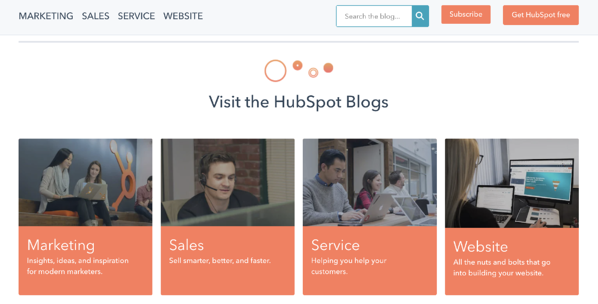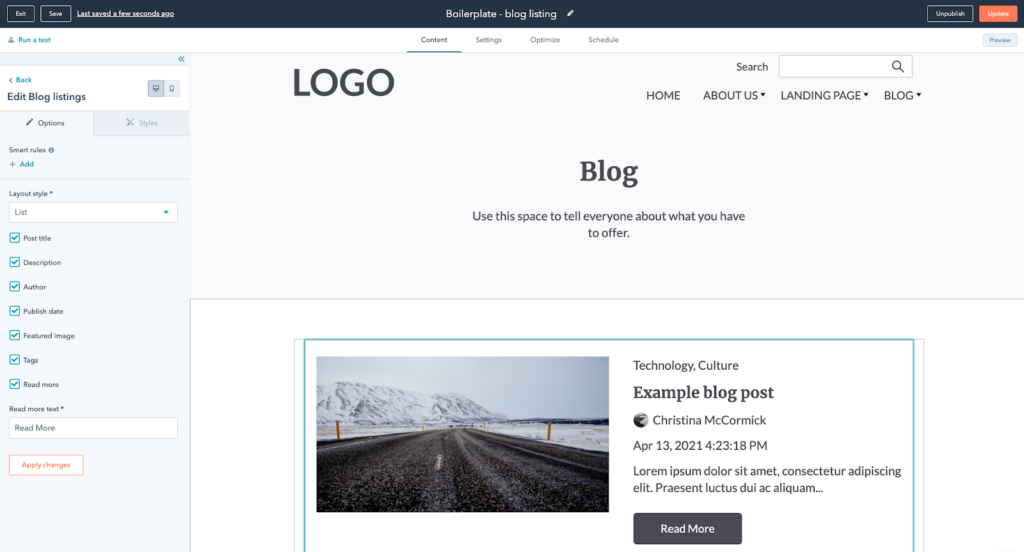
Table of Contents
- What is HubSpot?
- Evolution of HubSpot Blogs
- Key Takeaways
- Conclusion
- FAQs
In technical terms, blogging refers to writing, photography, and other media that is self-published online. What once started as an opportunity for individuals to digitally maintain a diary, blogging gradually evolved into one of the most critical elements in the content marketing mix. Businesses have increasingly incorporated blogging as a part of their content, social media, and marketing strategies. The evolution of HubSpot blogs is a fine example of the same.
What is HubSpot?
Before we start talking about the evolution of HubSpot blogs, it is important to know what HubSpot is. HubSpot is a cloud-based CRM designed to help align sales and marketing teams. It fosters sales enablement, boosts ROI, and optimizes your inbound marketing strategy, resulting in more qualified leads. Now transformed into a marketing platform, HubSpot helps companies market and sell their products and services more effectively.
HubSpot changed the way people buy and sell products online. HubSpot was conceived from the idea of inbound marketing, which focused on getting people’s attention without making them feel as if they were being interrupted by a salesperson. While it started in 2006 as an inbound marketing tool, HubSpot grew into a powerful growth engine. What began with just three customers is now going strong in numbers.
Evolution of HubSpot Blogs
The HubSpot blog was launched in 2014 under the Service Hub. Known as the Knowledge Base, HubSpot’s blog is now fully-featured. Here is a step-by-step outline of the HubSpot blog’s journey.

1. A minimal viable product at the beginning
HubSpot started as a minimal viable product (MVP) at the start. It was simply a knowledge base when it began. The HubSpot blog’s aim for its initial stage was to allow its users to publish answers to their customers’ questions online and allow customers to find answers to their queries. HubSpot helped its users do these two things as easily as possible. The MVP was equipped with,
- A simple editor to provide a focused writing experience
- Article categories
- Basic insights
- Basic design
Many HubSpot users received this MVP well and launched their knowledge bases. But there was a fundamental issue that led to customers questioning why there was a need for a knowledge base; why not use blogs and website pages to convey the same information. The value was missing from the HubSpot blog’s MVP.
2. Differentiating the knowledge base from other products
The second step in the evolution of the HubSpot blogs was to address this issue. HubSpot found two solutions to this problem. Firstly, they doubled down on the article categories. They understood that a knowledge base should provide quick and easy answers to a customer, and they added categories to make the answers even more browsable and easy to find. The drag-and-drop organize editor was used for this optimization.

Secondly, HubSpot blogs narrowed down to a few insights that mattered to their users. This included article health and search insights. With this immediate problem addressed, the customers understood the value of the knowledge base.
3. Improving adoption
HubSpot blog then moved on to improving the adoption of the knowledge base by the users. There were two major roadblocks to this,
- People who were already using an existing knowledge base would find the process of moving over time-consuming.
- Many businesses were fearful that the help content available on the knowledge base could even be accessed by their competitors, while it was just meant to be used by the customers.
They introduced an import option that allowed users to import a knowledge base from any platform in just two clicks, tackling the first issue. After the users entered their existing knowledge base’s URL, the HubSpot blog would take care of the rest. To deal with the problem of competitors’ accessibility, HubSpot blogs extended the new Content Membership feature, which would allow restricted access. This would allow help content to be made accessible to the customers of a particular business.
4. Clean House
After the adoption number rose, the HubSpot blog paused the process of working on new features and instead channelized its efforts on improvement. They improved the overall functioning and performance of the MVP. The improvement plan was segregated into three main areas.
- The article editor: Many people use HubSpot for blogging; therefore, most of the users’ time in the knowledge base is spent on writing articles. There were several problems that the users were facing at this stage: pasting images into the editor, adding images to ordered lists, embedding 3rd party videos and media elements, working with code-formatted sections, adding tables and anchors, and indenting items in lists. To solve these problems, HubSpot switched from Draft.js to TinyMCE. The article editor was carefully rebuilt to bring consistency to the customers’ experience.
- Enhancing the writing experience- Next on the list of the evolution of HubSpot blogs was solving the issues of- tables, anchor links, code formatting, and highlighting. All these features were added to the editor, along with callouts. Writers could also highlight important areas for the readers.
- Improving design: HubSpot, as an MVP, lacked design control. Many users were having trouble representing their brands properly on the knowledge base. Choosing fonts was not an option, neither was adding images on your own. To deal with this issue, HubSpot blogs opened up the template code of the Knowledge Base. But this gave birth to a new problem. The users who were not well-equipped with coding knowledge would be left behind. A non-technical system was then employed by providing users with the popular knowledge base templates. This allowed the non-technical users to keep pace with people who have the technical know-how of designing.
5. Constantly trying to improve the product.
What makes the evolution of HubSpot blogs a journey to learn so much from is their constant vigor to improve their product. After it mastered the new template experience, many large businesses started turning to the Knowledge Base. But with a larger number of big businesses, new and enhanced complexities also arise. Large businesses want to support multiple brands within their business, add multiple language services, and have their own developers and designers.
HubSpot constantly strives to improve its services and platform thoroughly. It believes that no product is ever completely finished. They are still working on improving the Knowledge Base as much as they can to ensure a seamless customer experience.
Key Takeaways
- HubSpot is a cloud-based CRM designed to help align sales and marketing teams. HubSpot helps companies market and sell more effectively.
- HubSpot was conceived from the idea of inbound marketing.
- The aim of the HubSpot blog for its initial stage was to allow its users to publish answers to their customers’ questions online and allow the customers to find answers to their queries.
- HubSpot added value to its MVP by doubling down on its article categories and narrowing them to a few selected insights.
- To deal with the problem of the fear of competitors, HubSpot blogs extended the new Content Membership feature, which would allow restricted access.
- By improving the article editor, enhancing the writing experience, and working on the design, HubSpot aimed at bringing consistency to the customers’ experience.
- HubSpot introduced an import option, making it convenient for users to import a knowledge base from any platform.
- Since many users were unable to represent their brands properly on the knowledge Base, HubSpot opened up the template code of the Knowledge Base.
- HubSpot believes that no product is ever completely finished.
Conclusion
Blogging on HubSpot is efficient and an experience in itself. Some attributes that make HubSpot attractive are branching in workflows, suggestion streams in social media, email optimization, list analytics, expanding revenue reporting, and more. Therefore, it is essential to learn from the HubSpot blog examples to perfect the art of blogging.

FAQs
You can easily manage your inbound campaigns by hosting your blog with HubSpot.
Some of the key features of HubSpot are SEO optimization, CTA creation, analytics, hosting comes with your software package, landing page creation, customizable website templates, A/B testing, integrated blogging, and more.
3,931 companies reportedly use HubSpot in their etch stacks: this includes Accenture, Strava, Trello, Mollie, Trustpilot, Yousign, GitBook, and Ruangguru.
HubSpot and Salesforce’s integration creates a bridge between your marketing and sales database. This allows activity and information to move seamlessly between the two databases.
CRM stands for customer relationship management. It is a data-driven software solution that improves your interaction with your customers.
Latest Blogs
Explore how Google’s 2025 AI search updates triggered ranking chaos. Learn actionable strategies to adapt your SEO for AI Overviews, zero-click searches, and SERP volatility. Stay ahead now.
Learn how to rank on AI search engines like ChatGPT, Perplexity, and Gemini by optimizing your content for authority, structure, and relevance. Stay ahead in AI-driven search with this strategic guide.
Explore the best healthcare SEO services for your medical practice. Improve online visibility and effectively reach more patients in need of your services.
Get your hands on the latest news!
Similar Posts

Content Analytics
8 mins read
Google I/O 2025: AI Search Shake-Up & Ranking Volatility

Artificial Intelligence
5 mins read
Top AI Blog Writing Tools for Website Monetization

Blogging
10 mins read